Annapurna Circuit
The Annapurna Circuit is one of the most renowned and treasured trekking routes in the world, and it offers an equally spectacular experience for mountain biking enthusiasts. Circling the Annapurna massif in the Himalayas of Nepal, this trail presents a unique blend of breathtaking natural beauty, diverse cultural experiences, and challenging terrain that attracts adventurers from around the globe.
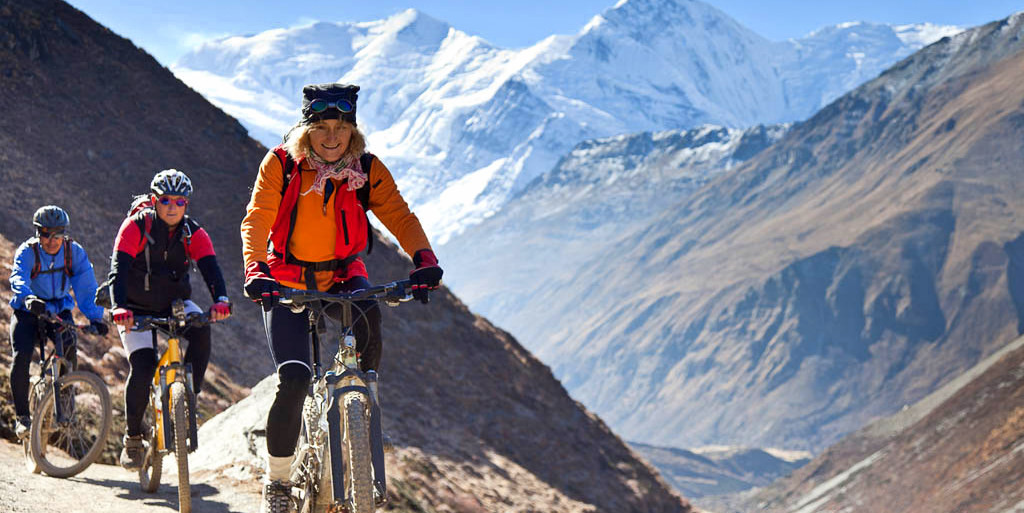
Key Features of the Annapurna Circuit for Mountain Biking
-
Scenic Diversity: The circuit provides a dramatic display of landscapes that change from lush subtropical forests and paddy fields in the lower regions to high alpine peaks and arid cliffs in the upper zones. Bikers can witness the stunning contrasts within a single journey.
-
Altitude Range: Starting at just under 800 meters above sea level, the route ascends to the high point of Thorong La Pass at 5,416 meters. This high-altitude pass is one of the biggest draws, offering panoramic views and a thrilling sense of accomplishment.
-
Cultural Immersion: The trail winds through various villages belonging to different ethnic groups, including Tamang, Gurung, and Thakali communities. This offers bikers an opportunity to experience the rich cultural heritage of Nepal firsthand. Each village along the way has its own customs, traditions, and often a local festival that might coincide with your visit.
-
Length and Duration: Typically, the Annapurna Circuit can be biked in about 10 to 15 days, depending on the starting point and pace of travel. The entire route covers approximately 160-230 kilometers, making it an extensive journey that requires good stamina and physical fitness.
-
Challenges and Thrills: Mountain biking on the Annapurna Circuit is not just about endurance; it also challenges bikers with varied terrains, including steep ascents, rapid descents, and rocky paths. The natural elements like altitude and weather further test the bikers’ limits.
-
Accessibility and Support: The route is well-marked and supported by several tea houses and lodges that provide food and accommodations. This infrastructure makes it possible for bikers to travel light and still enjoy a comfortable journey.
-
Sustainability and Respect: As with any adventure in natural and cultural settings, bikers are encouraged to respect the local environment and culture. This means following established trails, maintaining cleanliness, and being considerate towards the local communities.
Biking the Annapurna Circuit is an unforgettable adventure that offers more than just a physical challenge—it’s a profound journey through some of the most stunning landscapes on Earth and a deep dive into the heart of Nepalese culture. Whether you are an experienced mountain biker or a keen adventurer looking to try something new, the Annapurna Circuit promises an enriching and exhilarating experience.
Upper Mustang
Upper Mustang, often referred to as the "Last Forbidden Kingdom," is a remote and starkly beautiful region in the Himalayas of Nepal that offers a unique and adventurous destination for mountain biking. This area was restricted to outsiders until 1992, which helped preserve its mystique and traditional Tibetan culture. Biking through Upper Mustang is not just a physical journey but a voyage back in time, exploring ancient landscapes and centuries-old monasteries, all set against the dramatic backdrop of the Himalayan desert.

Key Features of Upper Mustang for Mountain Biking
-
Lunar Landscapes: The terrain of Upper Mustang is often compared to the Tibetan Plateau, with its arid, desolate, and rugged landscapes. It features wind-eroded hills, deep canyons, and striking rock formations, creating a surreal environment that feels more like another planet than part of Earth.
-
Rich Culture: Despite its isolation, Upper Mustang is vibrant with Tibetan Buddhist culture. The region is dotted with old monasteries, chortens, prayer flags, and mani walls. The town of Lo Manthang, the historical capital, is a highlight with its royal palace and surrounding monasteries, offering a glimpse into the region's rich history and spiritual life.
-
Altitude and Climate: Situated at altitudes ranging from 3,000 to 4,000 meters, Upper Mustang is a high-altitude desert. The area receives very little rainfall, making it ideal for mountain biking even during the monsoon season, when other parts of Nepal are wet and muddy.
-
Challenges: The trails in Upper Mustang are less traveled and can be quite challenging due to their rocky terrain and the altitude. Bikers need to be reasonably fit and experienced in handling difficult trails. The remoteness of the area also means that riders need to be prepared with the right gear and supplies.
-
Permits and Regulations: Access to Upper Mustang is controlled to protect its ecology and culture. Bikers must obtain a special permit and are typically required to travel with a guide. These measures help ensure that the region remains unspoiled.
-
Sustainable Travel: Given its sensitive environment and culture, sustainable travel practices are crucial in Upper Mustang. Bikers are encouraged to minimize their impact by following the principles of Leave No Trace, ensuring that they do not disturb the natural and cultural settings.
-
Unparalleled Views: The region offers magnificent views of the Annapurna and Dhaulagiri ranges. The contrast between the stark high desert terrain and the snow-capped peaks in the distance creates breathtaking vistas that are unmatched anywhere else in the world.
Mountain biking in Upper Mustang is an adventure that goes beyond conventional trail riding. It’s an exploration of a mysterious and preserved corner of the Himalayas, offering both natural and cultural treasures that are as challenging as they are rewarding. For those looking for a truly unique biking experience, Upper Mustang stands out as a destination that combines adventure with a deep sense of history and spirituality.
Kathmandu Valley
Kathmandu Valley, nestled in the heart of Nepal, offers a vibrant and accessible setting for mountain biking, blending historical richness with natural splendor. The valley, surrounded by rolling hills and dotted with lush forests and ancient cultural sites, provides a varied terrain ideal for bikers of all skill levels. From novice riders to experienced mountain bikers, Kathmandu Valley has something to offer everyone who wants to explore its landscapes on two wheels.
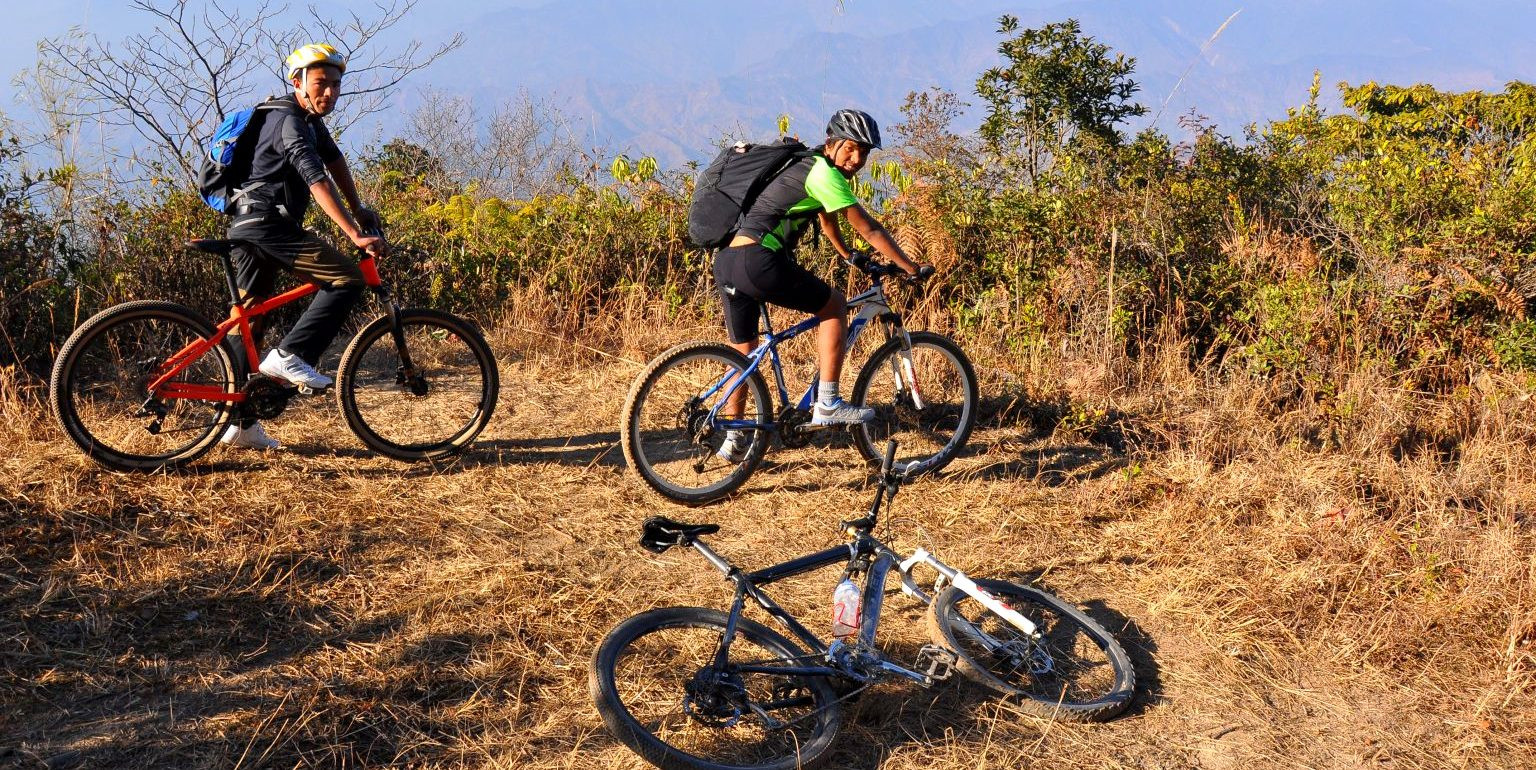
Key Features of Mountain Biking in Kathmandu Valley
-
Diverse Trails: The valley features an extensive network of trails that run through rice fields, rural villages, and along ridges with panoramic views of the majestic Himalayas. These trails range from easy jaunts suitable for families to technical tracks that challenge even seasoned bikers.
-
Cultural Encounters: Kathmandu Valley is rich in cultural heritage, home to several UNESCO World Heritage Sites like the temples and squares of Kathmandu, Patan, and Bhaktapur. Biking here offers a unique opportunity to combine physical activity with cultural exploration, allowing riders to stop at ancient sites and experience the local lifestyle up close.
-
Accessibility: One of the great advantages of biking in Kathmandu Valley is its accessibility. Just a short distance from the bustling city center, riders can quickly find themselves in the serene countryside or climbing to scenic viewpoints, making it easy to fit a ride into a morning or afternoon.
-
Guided Tours: Many local agencies, including those specializing in mountain biking, offer guided tours that cater to all levels of experience. These tours not only provide insights into the best trails and hidden gems of the valley but also include logistical support such as bike rentals, meals, and maintenance.
-
Year-Round Riding: Unlike the more seasonal biking destinations in the higher altitudes of Nepal, Kathmandu Valley can be enjoyed year-round. The post-monsoon months of September to November and the pre-monsoon months from February to May offer the best weather, but even in the winter and monsoon seasons, there are enjoyable and safe routes available.
-
Community and Events: The mountain biking community in Kathmandu is active and welcoming, with regular events, races, and social rides that make it easy for visitors to integrate and enjoy the local biking culture. These events are great for meeting fellow biking enthusiasts and learning more about the sport.
-
Scenic Beauty: The natural landscape of Kathmandu Valley, with its traditional farms, ancient forests, and bird-filled wetlands, offers a peaceful escape from the urban noise. The views from trails around the valley encompass not only the urban centers but also extend to distant, snow-covered peaks on clear days.
Mountain biking in Kathmandu Valley is an exciting way to experience the natural and cultural beauty of Nepal without venturing too far from the capital. It offers a perfect blend of adventure, convenience, and cultural immersion, making it an ideal choice for those looking to explore on two wheels. Whether you're a resident or a visitor, the trails of Kathmandu Valley promise a rewarding and memorable biking experience.
Jomsom Muktinath Trail
The Jomsom Muktinath Trail, part of the greater Annapurna Circuit, is a popular route in Nepal that offers an exhilarating mix of high-altitude landscapes, cultural diversity, and biking challenges. This trail is especially famous among mountain bikers for its stunning scenic views and the unique experience of biking through a transition zone where the lush vegetation of the lower Mustang region meets the arid, Tibetan-like landscape of the upper Mustang.
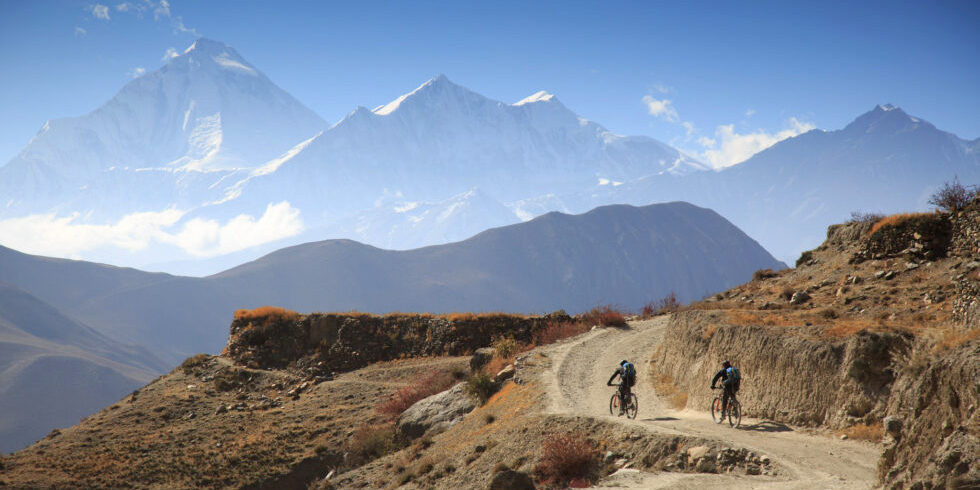
Key Features of the Jomsom Muktinath Trail for Mountain Biking
-
Dramatic Scenery: The trail offers some of the most dramatic landscapes in Nepal, featuring views of towering peaks such as Dhaulagiri and Nilgiri. The journey includes diverse terrains, from rocky trails and sandy paths to riverside routes and ancient salt trade routes.
-
Cultural Richness: The trail passes through a variety of villages where bikers can experience the rich culture of both the Hindu and Buddhist communities. The town of Jomsom is a bustling hub with a mix of trekkers and pilgrims, while Muktinath is a sacred site for both Hindus and Buddhists, providing a profound spiritual dimension to the journey.
-
Altitude Experience: Starting from Jomsom at about 2,700 meters, the trail climbs up to Muktinath at 3,760 meters. This high-altitude ride not only challenges bikers physically but also offers an opportunity to experience the thin mountain air and stark beauty of Nepal's high-altitude landscapes.
-
Accessibility and Convenience: The Jomsom Muktinath Trail is relatively accessible compared to other high-altitude biking routes in Nepal. Jomsom can be reached by a short flight from Pokhara, making it a convenient starting point for the trail. Additionally, the availability of guesthouses and teahouses along the route ensures that bikers can enjoy a comfortable journey with basic amenities.
-
Technical Challenges: The trail offers a variety of technical challenges that appeal to intermediate and advanced mountain bikers. The route includes steep ascents, rapid descents, and some loose, gravelly sections that require good bike handling skills.
-
Weather and Climate: The region falls in the rain shadow of the Himalayas, which means it receives less rainfall even during the monsoon season, making it a viable option for biking throughout the year. However, bikers should be prepared for strong winds, especially in the afternoon.
-
Sustainable Tourism: The trail promotes sustainable tourism practices with an emphasis on respecting local customs and minimizing environmental impact. Bikers are encouraged to follow eco-friendly practices, such as carrying out all trash and using water sparingly.
Mountain biking on the Jomsom Muktinath Trail is not just a physical activity; it's an adventure that feeds the soul. It combines the physical challenges of mountain biking with the awe-inspiring beauty of the Himalayas and the warmth of the local cultures. This trail is a must-try for those who wish to explore the diverse landscapes and rich heritage of Nepal on two wheels, providing a fulfilling and memorable biking experience.
Pokhara to Kathmandu Trail
The Pokhara to Kathmandu trail is a captivating route for mountain bikers seeking a blend of adventure, scenic beauty, and cultural experiences while connecting two of Nepal’s most iconic cities. This trail not only challenges riders with its varying terrain but also enchants them with the stunning landscapes and vibrant communities along the way.
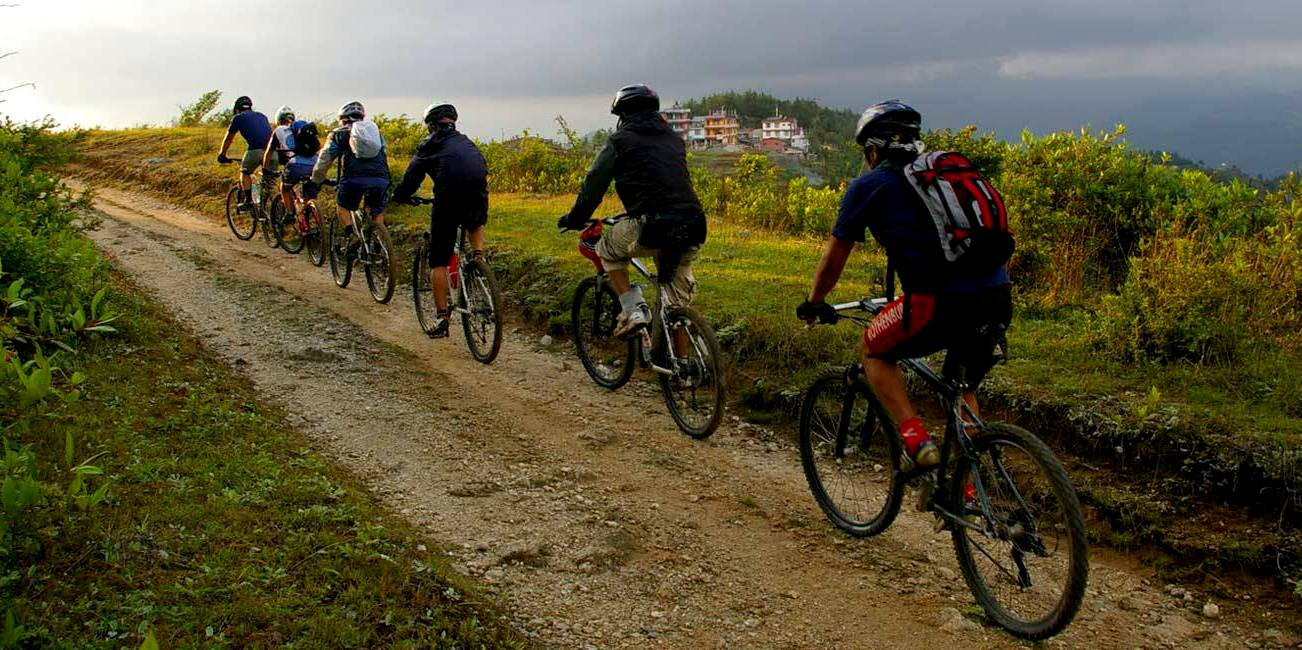
Key Features of the Pokhara to Kathmandu Trail for Mountain Biking
-
Diverse Landscapes: The trail spans a wide range of environments, from the lush, green valleys around Pokhara to the more arid and rugged mid-hills as you approach Kathmandu. Riders traverse through forests, rural farmlands, and small villages, each offering unique views and challenges.
-
Cultural Diversity: This trail provides a wonderful opportunity to experience the diverse cultural tapestry of Nepal. Bikers pass through various ethnic communities, each with its distinct traditions and lifestyles. These encounters provide insight into the rural life of Nepal, offering more than just a physical challenge but a deep cultural immersion.
-
Physical Challenge: The route includes a mix of uphill climbs and downhill rides, suitable for intermediate to advanced bikers. The varying elevations and terrains test the stamina and skills of riders, making it a fulfilling adventure for those looking for a physical challenge.
-
Historical and Natural Sites: Along the way, bikers can explore significant historical and natural sites. These might include ancient temples, historical towns, and viewpoints that offer panoramic views of the majestic Himalayan ranges.
-
Accessibility and Support: Given the popularity of both Pokhara and Kathmandu as tourist hubs, the trail is well-supported by local amenities. Bikers can find accommodation and dining options in the villages along the way, making it feasible to plan a multi-day biking trip with stops to rest and explore.
-
Weather Considerations: The best times to embark on this trail are during the spring (March to May) and autumn (September to November) seasons when the weather is most favorable. These periods provide clear skies and moderate temperatures, ideal for long rides.
-
Safety and Navigation: While the trail is marked, bikers should use GPS navigation or hire a local guide, especially for less experienced bikers. This ensures safety and enriches the experience as local guides can provide insights into the areas traversed.
Riding from Pokhara to Kathmandu by bike is not just a journey between two cities but a vibrant exploration of Nepal’s heartland. It offers a unique way to see the countryside, engage with local communities, and challenge oneself physically and mentally. This trail is perfect for those who want to combine their love for biking with an exploration of Nepal’s natural and cultural landscapes.
Manaslu Circuit
The Manaslu Circuit is a stunning and less-traveled alternative to more crowded routes like the Annapurna Circuit, offering mountain bikers a uniquely challenging and rewarding experience. This route encircles Mount Manaslu, the eighth highest mountain in the world, providing an up-close view of its majestic peak and the diverse landscapes surrounding it.

Key Features of the Manaslu Circuit for Mountain Biking
-
Remote and Rugged Terrain: The Manaslu Circuit is known for its remote and challenging tracks, which make it an ideal choice for adventurous bikers looking for a less commercialized experience. The trail traverses wild and untouched areas, offering pristine natural beauty.
-
Dramatic Scenery: The circuit showcases a dramatic change in scenery, from lush subtropical forests at lower elevations to the stark, rugged high-altitude landscapes as it approaches Larkya La Pass, the highest point on the trail at 5,106 meters (16,752 ft).
-
Cultural Richness: The route passes through various ethnic villages, including those inhabited by Gurung and Tibetan communities, offering bikers a chance to experience diverse cultures. The region is dotted with ancient Buddhist monasteries, chortens, and mani walls, enriching the spiritual aspect of the journey.
-
Physical Challenge: The Manaslu Circuit is physically demanding, with steep climbs and rapid descents. High-altitude biking, especially near Larkya La Pass, tests endurance and requires good acclimatization. This makes it suitable primarily for experienced bikers.
-
Wildlife and Flora: The region is part of the Manaslu Conservation Area, which is home to a rich array of biodiversity, including endangered species such as the snow leopard and the red panda. The flora changes dramatically as the elevation increases, adding to the scenic variety of the ride.
-
Regulations and Permits: Like the Upper Mustang, the Manaslu region requires special permits to enter, as it is a controlled area aimed at protecting the local environment and culture. Bikers need to arrange these permits in advance and are typically required to travel with a guide.
-
Best Seasons to Ride: The best times to undertake the Manaslu Circuit by bike are during the spring (March to May) and autumn (September to November) months when the weather is more stable and the visibility is clear, offering stunning views of Manaslu and the surrounding peaks.
The Manaslu Circuit offers an intense and immersive mountain biking experience. It's not just about the physical ride but also about connecting with nature and local traditions in one of the most spectacular settings in Nepal. The circuit's demanding nature and the requirement for permits and guides mean that it's less crowded, providing a more intimate and authentic adventure for those who take on its challenges.
Dhulikhel to Namobuddha
The Dhulikhel to Namobuddha biking trail is a beautifully scenic and culturally enriching route that offers a relatively easy yet rewarding adventure, ideal for both beginners and experienced bikers. Located just a short distance from Kathmandu, this trail provides a perfect day trip or a leisurely half-day ride through the picturesque landscapes of Nepal's Kavrepalanchok District.
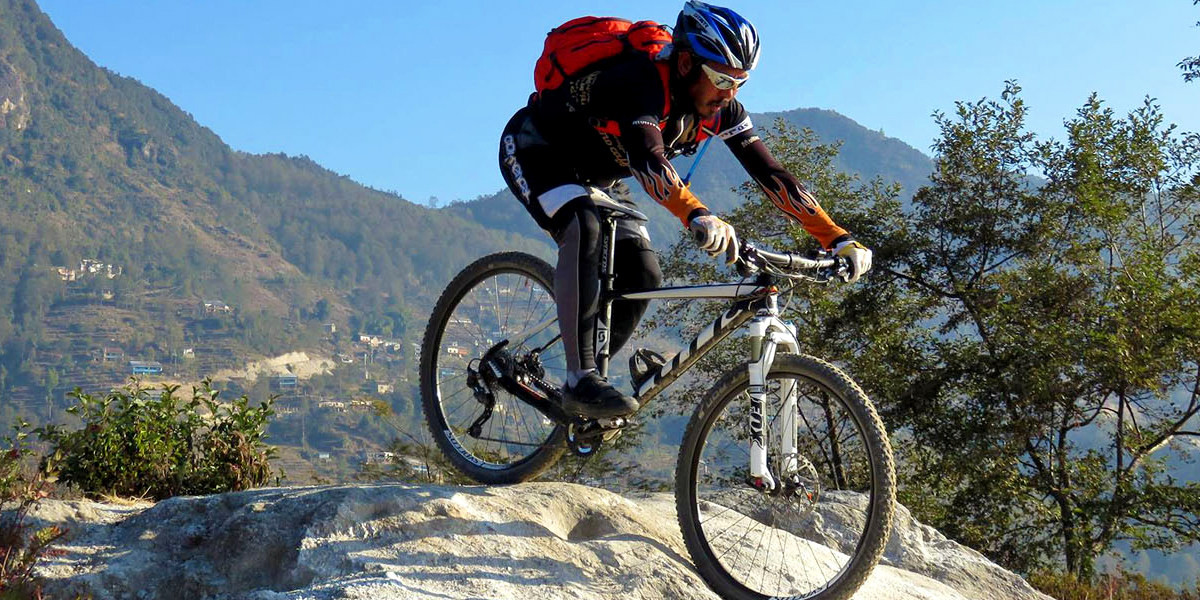
Key Features of the Dhulikhel to Namobuddha Biking Trail
-
Scenic Beauty: The trail from Dhulikhel to Namobuddha is known for its panoramic views of the Himalayan ranges, including peaks like Langtang, Gaurishankar, and Everest on clear days. The path winds through lush forests and traditional Nepalese villages, providing a peaceful escape from the bustling city life.
-
Cultural Experience: Namobuddha is one of the most important Buddhist pilgrimage sites in Nepal, reputedly the spot where a prince sacrificed himself to feed a starving tigress and her cubs. The monastery at Namobuddha, Thrangu Tashi Yangtse Monastery, is a significant attraction, offering insights into Buddhist traditions and practices.
-
Gentle Terrain: The route features a mix of paved roads and well-maintained dirt tracks, making it accessible for bikers of all skill levels. The climb to Namobuddha is gradual and offers various points to stop and enjoy the surroundings.
-
Accessibility: Dhulikhel is just about 30 kilometers east of Kathmandu, making it easily accessible by road. This proximity makes the Dhulikhel to Namobuddha trail a popular choice for those looking to experience mountain biking in Nepal without venturing too far from the capital.
-
Wildlife and Flora: The area around Dhulikhel and Namobuddha is rich in biodiversity. The forests along the route are home to various species of birds and small wildlife, making it a delight for nature enthusiasts.
-
Spiritual Significance: The spiritual aura of Namobuddha adds a unique dimension to the biking experience. Visitors often spend time in meditation or simply soaking in the peaceful vibes of the monastery grounds.
-
Ideal for Day Trips: Given its length and moderate difficulty level, the trail is perfect for day trips. Bikers can leave Kathmandu in the morning, enjoy a leisurely ride and lunch in Namobuddha, and return by the evening.
The Dhulikhel to Namobuddha biking route is not just a physical activity but a journey that touches on spiritual, cultural, and natural elements. It offers a serene biking experience that contrasts sharply with the adrenaline-pumping adventures found on Nepal's higher-altitude trails, making it a versatile option suitable for families, novice bikers, or those seeking a short yet fulfilling outdoor adventure.
Tips for Mountain Biking in Nepal
Mountain biking in Nepal is an exhilarating adventure that offers unique challenges and rewards. Here are some tips to ensure a safe and enjoyable experience:
-
Choose the Right Season: The best times for mountain biking in Nepal are during the spring (March to May) and autumn (September to November). These seasons provide stable weather and clear skies, offering the best views of the mountains. Monsoon season (June to August) can make trails slippery and difficult to navigate.
-
Select Appropriate Gear: A good quality mountain bike suited for rugged terrain is essential. Full-suspension bikes are often recommended for the varied and often rough terrains of Nepal. Additionally, always wear a helmet and consider other protective gear, such as gloves, knee pads, and elbow pads for safety.
-
Acclimatize Properly: If you’re planning rides at high altitudes, like the Annapurna Circuit or the Manaslu Circuit, it's crucial to acclimatize to avoid altitude sickness. Plan gradual ascents to give your body time to adjust to the higher elevations.
-
Hire Local Guides: Especially in remote areas like Upper Mustang or Manaslu, hiring a local guide can enhance your experience. Guides not only help with navigation but also share valuable insights about local culture and ensure you follow the best routes and practices.
-
Prepare for the Climate: Weather in the mountains can change rapidly. Dress in layers and be prepared for cold and windy conditions, especially at higher altitudes. Waterproof gear can be essential during the rainy season or in misty conditions.
-
Stay Hydrated and energized: Keep plenty of water and snacks on hand. Hydration is key at higher altitudes, and energy foods like bars, nuts, and dried fruits can help maintain your stamina throughout your ride.
-
Respect Local Customs: Many trails pass through villages with deep cultural traditions. Be respectful of local customs and practices, dress modestly, and always ask permission before taking photos of people.
-
Plan Your Route and Accommodation: Depending on your route, accommodation options might range from guesthouses and teahouses to camping. Plan your itinerary, considering where you can stop for rest and overnight stays.
-
Carry a Repair Kit and Know Basic Maintenance: Being able to handle a flat tire or a loose chain on your own is important, especially in remote areas. Carry a basic repair kit and familiarize yourself with basic bike maintenance before you go.
-
Use GPS and Maps: While many trails are well-marked, having a GPS device or at least a reliable map can prevent you from getting lost. This is particularly important in less traveled areas.
-
Emergency Preparedness: Carry a basic first aid kit and know the emergency services numbers in Nepal. If you’re in a remote area, consider carrying a satellite phone or a personal locator beacon.
By following these tips, you'll be better prepared to enjoy the breathtaking landscapes and thrilling trails of mountain biking in Nepal safely and responsibly.
Ideal Time for Mountain Biking in Nepal
Mountain biking in Nepal offers an exciting adventure, but choosing the right time for your trip can significantly enhance the experience. The ideal time for mountain biking in Nepal largely depends on the weather conditions, which vary between different regions and altitudes. Here’s a guide to the best times for biking in the various terrains of Nepal:
Pre-Monsoon Season (February to May): The pre-monsoon spring months from February to May are among the best times to go mountain biking in Nepal. During this period, the weather is generally dry and warm, which is ideal for biking. The skies are clear, providing excellent visibility of the majestic Himalayas. This is also the time when the natural landscape is vibrant, with rhododendrons and other wildflowers blooming, especially at lower altitudes.
-
Advantages: Stable weather, clear skies, and moderate temperatures make for enjoyable riding conditions. The natural beauty is at its peak with lush vegetation and blooming flowers.
-
Considerations: As it nears May, the temperature starts getting warmer, and the humidity increases as the monsoon approaches, which might affect comfort levels during rigorous biking.
Post-Monsoon Season (September to November): Autumn, from September to November, is considered the peak season for all types of outdoor activities in Nepal, including mountain biking. The monsoon rains have cleared the dust from the air, resulting in exceptionally clear skies and the best mountain views of the year. The weather is cool and dry, making it comfortable for long rides.
-
Advantages: Excellent weather and visibility conditions. This is also a festive season in Nepal, offering a great cultural experience alongside mountain biking adventures.
-
Considerations: These months can be quite busy on the more popular trails like the Annapurna Circuit, as this is the peak season for trekking as well.
Winter (December to January): Winter in Nepal can be cold, especially at higher altitudes, but it's still possible to enjoy mountain biking, particularly in lower regions like the Kathmandu Valley and around Pokhara. The tourist crowds are fewer, and the trails are less busy, providing a more solitary biking experience.
-
Advantages: Quieter trails and cooler conditions. Suitable for those who prefer a more solitary experience.
-
Considerations: Shorter days and colder weather, especially in the mornings and evenings. Snow may block higher passes and trails.
Monsoon Season (June to August): The monsoon season is generally considered less ideal for mountain biking due to heavy rains, slippery trails, and limited visibility. However, some areas like the Upper Mustang and parts of the Dolpo region lie in the rain shadow of the Himalayas and are less affected by the monsoon, making them viable options for mountain biking even during these months.
-
Advantages: Trails in rain-shadowed areas remain relatively dry and are less crowded.
-
Considerations: Frequent rains in other parts can lead to muddy and slippery conditions, making biking challenging and potentially hazardous.
The best general advice is to plan your mountain biking trip during the spring (February to May) or autumn (September to November) months when the weather is favorable and the views are at their best. This timing allows bikers to fully enjoy the scenic trails and cultural richness of Nepal without the extremes of monsoon rains or winter cold.
An amazing trip in Nepal, mountain biking marries awesome landscapes with deep cultural experiences over varied topography. Perfect in spring and fall for ideal weather, every path presents different difficulties and possibilities for riders at every level. Nepal offers deep cultural immersion as well as exciting trips from the high passes of the Annapurna Circuit to the ancient roads connecting Dhulikhel to Namobuddha. Local tour operators offer bikers extensive support so they can have a safe and unforgettable trip down the middle of the Himalayas, therefore transforming every trip.
FAQs for Mountain Biking in Nepal
Q: What is the best time of year for mountain biking in Nepal?
A: The optimal times for mountain biking are during the spring (March to May) and autumn (September to November) when the weather is stable and the visibility is high. Winter can also be suitable for lower-altitude rides.
Q: Do I need a guide for mountain biking in Nepal?
A: While not mandatory for all routes, hiring a guide is highly recommended, especially for remote or challenging trails. Guides provide not only navigation but also valuable insights into local culture and can assist in emergencies.
Q: What are the most popular mountain biking trails in Nepal?
A: Some of the most popular trails include the Annapurna Circuit, Upper Mustang, Jomsom Muktinath Trail, and routes around the Kathmandu Valley. Each offers unique scenery and varying difficulty levels.
Q: What should I pack for a mountain biking trip in Nepal?
A: Essential items include a reliable mountain bike, helmet, repair kit, water hydration system, appropriate clothing for variable weather, a first aid kit, and high-energy snacks. It’s also wise to carry a map and GPS device.
Q: How physically demanding is mountain biking in Nepal?
A: The physical demand varies by trail. Some routes, like the Kathmandu Valley, are suitable for beginners, while high-altitude trails like the Annapurna Circuit are more challenging and require good physical fitness and acclimatization to high altitudes.
Q: Are there any permits required for mountain biking in Nepal?
A: Certain areas, especially those in restricted regions like Upper Mustang, require special permits. It’s important to check the specific requirements for your chosen trail in advance.
Q: What are the risks of mountain biking in Nepal?
A: Common risks include altitude sickness, sudden weather changes, and challenging terrain. Proper preparation and adhering to safety guidelines can mitigate these risks.
Q: Can beginners participate in mountain biking in Nepal?
A: Yes, there are trails suitable for beginners, particularly around Kathmandu Valley and Pokhara. However, it’s important for beginners to have basic biking skills and ensure they choose routes that match their fitness and experience levels.
Q: How do I deal with altitude sickness while biking at high altitudes?
A: Acclimatize properly by ascending slowly, staying hydrated, eating a high-calorie diet, and resting adequately. If symptoms of altitude sickness occur, descend to a lower altitude and seek medical advice if necessary.
Q: Can I rent a mountain bike in Nepal, or should I bring my own?
A: You can rent mountain bikes in major cities like Kathmandu and Pokhara. Rental options range from basic models to high-end bikes suitable for rugged terrain. Bringing your bike is also an option, especially if you are particular about using equipment you are familiar with.
For the Nepal tour, please click here.
If you are looking for different kinds of Nepal Tours or Trekking Packages, feel free to contact us.









